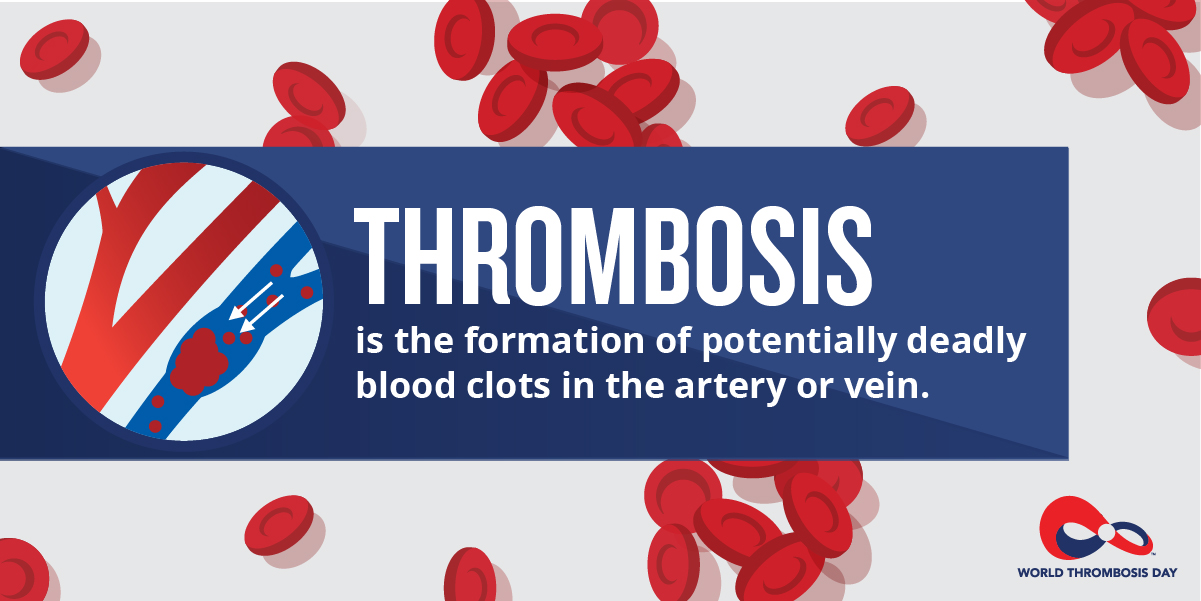Know the Facts: Know Thrombosis
1 in 4 people worldwide are dying from conditions caused by thrombosis. And, it's a startling fact that up to 900,000 people in the United States alone are affected by blood clots each year; about 100,000 of those people will die, which is greater than the total number of people who lose their lives each year to AIDS, breast cancer, and motor vehicle crashes combined.
 WHAT IS THROMBOSIS?
WHAT IS THROMBOSIS?
Thrombosis is the formation of a blood clot in a blood vessel. The vessel may be any vein or artery as for example, in a deep vein thrombosis (venous) or a coronary artery (arterial). The clot itself is termed a thrombus.
Once formed, a clot can slow or block normal blood flow, and even break loose and travel to an organ. A clot that travels to the circulation is called an embolism. Thrombosis is the often preventable underlying pathology of heart attack, thromboembolic stroke, and venous thromboembolism (VTE), the top three cardiovascular killers.
types of thrombosis
Thrombosis is normally categorized by where it occurs in the body. Within these categories, it may be classified further.
The two broad classifications of thrombosis are venous and arterial, depending on whether the clot develops in the vein or an artery. Venous and arterial thrombosis are variations of similar pathologic mechanisms. Both are influenced by acquired or inherited risk factors.
Venous thromboembolism or VTE is a condition in which blood clots form most often in the deep veins of the leg, known as deep vein thrombosis or DVT, and can travel in the circulation and lodge in the lungs, known as pulmonary embolism or PE. Remember this simple equation: DVT + PE = VTE (a deadly combination).
Thrombosis Risk Assessment and Prevention
 Research suggests that VTEs are often preventable, and evidence-based prevention strategies can stop the development of clots in 'at-risk' individuals.
Research suggests that VTEs are often preventable, and evidence-based prevention strategies can stop the development of clots in 'at-risk' individuals.
To identify whether a patient is 'at-risk,' healthcare professionals should conduct a VTE risk assessment, which is tool or questionnaire that gathers information about a patient's age, medical history, medications and specific lifestyle factors. Information is then used to discern a patient’s potential risk (e.g., high, moderate or low risk) for developing blood clots in the legs or lungs.
If you are admitted to a hospital and don't receive an assessment, be proactive. Ask for one.
What are the most common tests my care team may order to see if I have a blood clot?
- A blood test called a D-Dimer
- An ultrasound of the arm or leg to look for the DVT
- A CAT scan of the chest with intravenous dye to look for a PE
Individuals who are deemed 'at-risk' should be given appropriate prevention (referred to as "prophylaxis"), which can include:
- Anti-clotting medications (e.g., blood thinners, referred to as "anticoagulants")
- Mechanical devices (e.g., compression stockings, intermittent pneumatic compression devices or rapid inflation venous foot pumps)
Hospital patients may also be instructed to move around or do foot/leg exercises as soon and as often as possible.
Treatment
DVT and PE are serious, life-threatening conditions that require immediate medical attention. Treatment can differ by patient but typically includes blood thinning medication to break up clots and prevent new ones from forming. Depending on specific conditions, a patient might need:
- Anticoagulants (e.g., injectables such as heparin, enoxaparin, or low molecular weight heparin, or tablets such as apixaban, dabigatran and rivaroxaban, edaxaban and warfarin)
- Mechanical devices (e.g., compression stockings which may decrease your risk of long term problems that can be caused from having clots or a special filter placed in a vein)
- Thrombolytic therapy (e.g., tissue plasminogen activator)
Early diagnosis and treatment can often lead to recovery, but long-term complications, such as post-thrombotic syndrome and chronic thromboembolic pulmonary hypertension may occur.
know tHRombosis: A Global Priority
Thrombosis does not discriminate. Clots can affect anyone regardless of location, age, ethnicity or race. The most important thing you can do to protect yourself from a life-threatening blood clot is to learn if you are at risk. Know the signs and symptoms and contact your health care professional immediately if needed.
In 2012, the World Health Assembly (WHA) set a global target to reduce premature deaths from non-infectious disease - including cardiovascular disease - by 25 percent by 2025. To meet this goal, WTD and our partners believe that the WHA must directly address thrombosis, specifically VTE and AFib.
The ISTH and WTD steering committee continues to call for increased attention to thrombosis, first in a statement to the World Health Organization's (WHO) 68th World Health Assembly in 2015. Key to this effort is the inclusion of VTE as a specific cause of death in the WHO's next Global Burden of Disease study. Will you help?
To learn more about the global burden of the VTE, click here.
